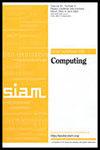Rounds vs. Communication Tradeoffs for Maximal Independent Sets
IF 1.6
3区 计算机科学
Q3 COMPUTER SCIENCE, THEORY & METHODS
引用次数: 0
Abstract
SIAM Journal on Computing, Ahead of Print.Abstract. We consider the problem of finding a maximal independent set (MIS) in the shared blackboard communication model with vertex-partitioned inputs. There are [math] players corresponding to vertices of an undirected graph, and each player sees the edges incident on its vertex; this way, each edge is known by both its endpoints and is thus shared by two players. The players communicate in simultaneous rounds by posting their messages on a shared blackboard visible to all players, with the goal of computing an MIS of the graph. While the MIS problem is well studied in other distributed models and while shared blackboard is, perhaps, the simplest broadcast model, lower bounds for our problem were only known against one-round protocols. We present a lower bound on the round-communication tradeoff for computing an MIS in this model. Specifically, we show that, when [math] rounds of interaction are allowed, at least one player needs to communicate [math] bits. In particular, with logarithmic bandwidth, finding an MIS requires [math] rounds. This lower bound can be compared with the algorithm of Ghaffari et al. [Proceedings of the 2018 ACM Symposium on Principles of Distributed Computing, 2018, pp. 129–138] that solves the MIS in [math] rounds but with a logarithmic bandwidth for an average player. Additionally, our lower bound further extends to the closely related problem of maximal bipartite matching. The presence of edge-sharing gives the algorithms in our model a surprising power, and numerous algorithmic results exploiting this power are known. For a similar reason, proving lower bounds in this model is much more challenging because this sharing in the players’ inputs prohibits the use of standard number-in-hand communication complexity arguments. Thus, to prove our results, we devise a new round elimination framework, which we call partial-input embedding, that may also be useful in future work for proving round-sensitive lower bounds in the presence of shared inputs. Finally, we discuss several implications of our results to multiround (adaptive) distributed sketching algorithms, broadcast congested clique, and the welfare maximization problem in two-sided matching markets.
最大独立集的轮次与通信权衡
SIAM 计算期刊》,提前印刷。 摘要我们考虑的是在顶点分区输入的共享黑板通信模型中寻找最大独立集(MIS)的问题。无向图的顶点对应着 [math] 玩家,每个玩家都能看到自己顶点上的边,这样,每条边的端点都是已知的,因此由两个玩家共享。棋手在同时进行的几轮比赛中,通过在所有棋手都能看到的共享黑板上发布信息进行交流,目的是计算图的 MIS。虽然 MIS 问题在其他分布式模型中得到了很好的研究,而且共享黑板也许是最简单的广播模型,但我们的问题的下界只针对一轮协议。我们提出了在该模型中计算 MIS 的回合-通信权衡下限。具体来说,我们证明了当允许 [math] 轮交互时,至少有一个玩家需要通信 [math] 比特。特别是在带宽为对数的情况下,找到一个 MIS 需要 [math] 轮。这个下界可以与 Ghaffari 等人的算法[Proceedings of the 2018 ACM Symposium on Principles of Distributed Computing, 2018, pp.此外,我们的下界还进一步扩展到了密切相关的最大双方格匹配问题。边缘共享的存在给我们模型中的算法带来了惊人的威力,利用这种威力的算法结果不胜枚举。出于类似的原因,在这个模型中证明下界更具挑战性,因为玩家输入的共享禁止使用标准的手数通信复杂度论证。因此,为了证明我们的结果,我们设计了一个新的回合消除框架,我们称之为部分输入嵌入(partial-input embedding)。最后,我们讨论了我们的结果对多轮(自适应)分布式草图算法、广播拥塞小集团以及双面匹配市场中的福利最大化问题的若干影响。
本文章由计算机程序翻译,如有差异,请以英文原文为准。
求助全文
约1分钟内获得全文
求助全文
来源期刊

SIAM Journal on Computing
工程技术-计算机:理论方法
CiteScore
4.60
自引率
0.00%
发文量
68
审稿时长
6-12 weeks
期刊介绍:
The SIAM Journal on Computing aims to provide coverage of the most significant work going on in the mathematical and formal aspects of computer science and nonnumerical computing. Submissions must be clearly written and make a significant technical contribution. Topics include but are not limited to analysis and design of algorithms, algorithmic game theory, data structures, computational complexity, computational algebra, computational aspects of combinatorics and graph theory, computational biology, computational geometry, computational robotics, the mathematical aspects of programming languages, artificial intelligence, computational learning, databases, information retrieval, cryptography, networks, distributed computing, parallel algorithms, and computer architecture.
 求助内容:
求助内容: 应助结果提醒方式:
应助结果提醒方式:


